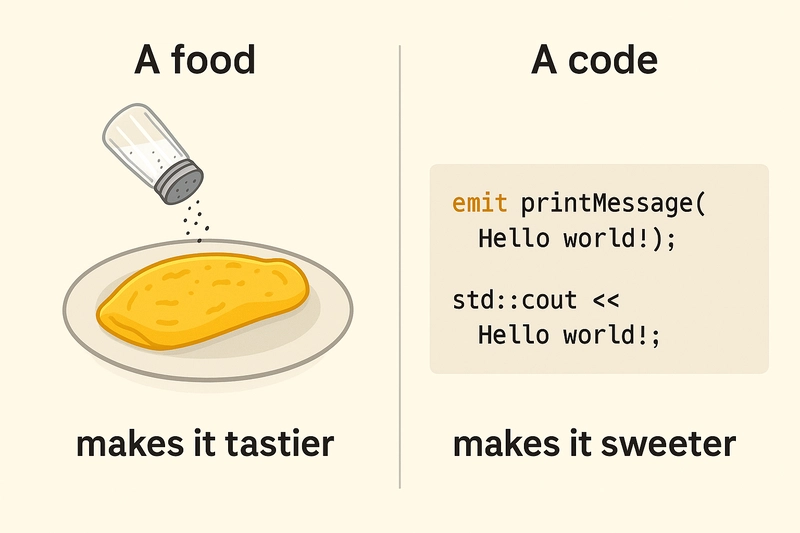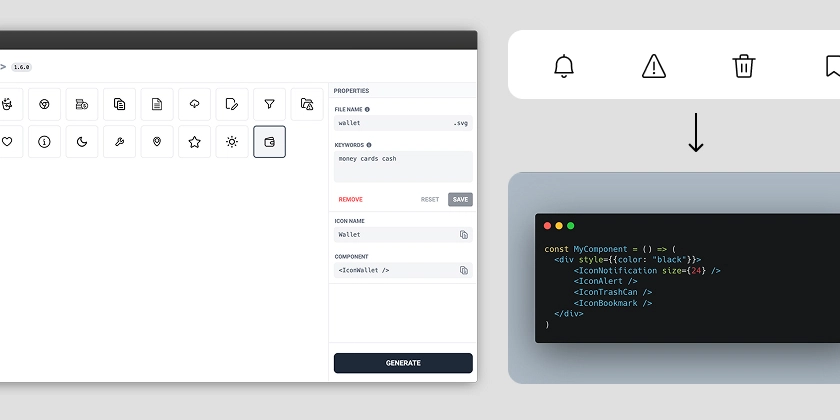Getting to Know Syntactic Sugar in Programming
Firstly, I wrote this blog to raise awareness about syntactic sugar. Sometimes, we come across two different pieces of code that perform the same functionality. This can lead us to wonder: "What’s the difference between these two approaches?" In many cases, the simpler or more elegant version is a result of syntactic sugar. That’s why I decided to write this blog — to help clarify what syntactic sugar is and why it matters. Every programming language has its own syntax rules, which define how code must be written in that language. These syntax rules determine the structure and form of valid code. Sometimes, a new syntax is introduced into a language that does not change the functionality but rather makes the code easier or more pleasant to write. These kinds of syntax additions are referred to as syntactic sugar. In recent years, we’ve seen many modern programming languages introducing new syntactic features. These additions are often designed to improve developer experience by making code shorter, cleaner, and easier to understand. However, not everyone agrees that syntactic sugar is always beneficial. While syntactic sugar offers significant advantages in terms of readability and ease of writing, some programmers argue that these features can be unimportant or even frivolous. They believe that special syntactic forms can make a language less uniform and more complex, which could lead to problems as programs grow larger and more intricate. Alan Perlis, a well-known figure in the programming world, shared short yet thought-provoking statements about software in his work "Epigrams on Programming." He expressed his opinion on syntactic sugar with a witty remark: "Syntactic sugar causes cancer of the semi-colons." Syntactic Sugar Syntactic sugar refers to language features that make code easier to read or write. These features don’t introduce new functionality — they just give you a sweeter way to express existing logic. In fact, It is a syntax or language features that is designed to make easier to understand or express things. All of these features are for us to use to express things very cleary and tell. Why “Sugar”? The term "sugar" in syntactic sugar is used because it sweetens the syntax without being strictly necessary for functionality. It makes the code more readable and expressive — like adding spices to food. For example, when cooking an omelette, it’s just an omelette on its own. But when you add some spices, it becomes more flavorful and enjoyable. In this analogy, you can think of syntactic sugar as the spices that enhance the experience, even though they aren’t essential to the basic function of the code. Relation With Refactoring In software development, refactoring is the practice of cleaning up code without changing its functionality. The primary goal of refactoring is to improve the code’s readability, maintainability, and sustainability, while ensuring that the system’s behavior remains unchanged. This process improves software quality and makes future changes easier to implement. Refactoring can also include performance optimizations, such as eliminating redundant calculations or improving algorithm efficiency. Another concept in software development is syntactic sugar. Syntactic sugar refers to certain syntax features or structural shortcuts in a programming language that allow developers to express the same functionality in a more readable, concise, and aesthetically pleasing way. While it doesn’t change the underlying functionality, it improves the developer’s experience by making the code more intuitive and easier to understand. Importantly, syntactic sugar typically does not provide performance improvements, as it only alters the appearance of the code without affecting how it runs. Refactoring and syntactic sugar share a similar relationship. Both are techniques used to enhance readability, and maintainability of code. However, refactoring can sometimes include performance improvements, while syntactic sugar is focused purely on making the code easier to read and write. Refactoring often employs syntactic sugar to simplify code and improve its appearance. History The term "Syntactic Sugar" was coined in 1964 by computer scientist Peter J. Landin. At the time, he used it to describe the surface syntax of an ALGOL-like programming language (ALGOL was one of the popular languages of that era). The semantics of this language — that is, how it actually worked — were defined in terms of lambda calculus, a formal system foundational to functional programming. Landin proposed replacing the "λ" (lambda) operator with more readable keywords like "where", to make the code easier to read and write. This kind of syntactic simplification — where the underlying functionality stays the same, but the code becomes easier to work with — was what he called syntactic sugar. Examples QT Emit Keyword For example, in C++ with Qt, we use signals to notify other parts of the program wh

Firstly, I wrote this blog to raise awareness about syntactic sugar.
Sometimes, we come across two different pieces of code that perform the same functionality. This can lead us to wonder: "What’s the difference between these two approaches?"
In many cases, the simpler or more elegant version is a result of syntactic sugar. That’s why I decided to write this blog — to help clarify what syntactic sugar is and why it matters.
Every programming language has its own syntax rules, which define how code must be written in that language. These syntax rules determine the structure and form of valid code. Sometimes, a new syntax is introduced into a language that does not change the functionality but rather makes the code easier or more pleasant to write. These kinds of syntax additions are referred to as syntactic sugar. In recent years, we’ve seen many modern programming languages introducing new syntactic features. These additions are often designed to improve developer experience by making code shorter, cleaner, and easier to understand. However, not everyone agrees that syntactic sugar is always beneficial. While syntactic sugar offers significant advantages in terms of readability and ease of writing, some programmers argue that these features can be unimportant or even frivolous. They believe that special syntactic forms can make a language less uniform and more complex, which could lead to problems as programs grow larger and more intricate.
Alan Perlis, a well-known figure in the programming world, shared short yet thought-provoking statements about software in his work "Epigrams on Programming." He expressed his opinion on syntactic sugar with a witty remark:
"Syntactic sugar causes cancer of the semi-colons."
Syntactic Sugar
Syntactic sugar refers to language features that make code easier to read or write. These features don’t introduce new functionality — they just give you a sweeter way to express existing logic. In fact, It is a syntax or language features that is designed to make easier to understand or express things. All of these features are for us to use to express things very cleary and tell.
Why “Sugar”?
The term "sugar" in syntactic sugar is used because it sweetens the syntax without being strictly necessary for functionality. It makes the code more readable and expressive — like adding spices to food. For example, when cooking an omelette, it’s just an omelette on its own. But when you add some spices, it becomes more flavorful and enjoyable. In this analogy, you can think of syntactic sugar as the spices that enhance the experience, even though they aren’t essential to the basic function of the code.
Relation With Refactoring
In software development, refactoring is the practice of cleaning up code without changing its functionality. The primary goal of refactoring is to improve the code’s readability, maintainability, and sustainability, while ensuring that the system’s behavior remains unchanged. This process improves software quality and makes future changes easier to implement. Refactoring can also include performance optimizations, such as eliminating redundant calculations or improving algorithm efficiency.
Another concept in software development is syntactic sugar. Syntactic sugar refers to certain syntax features or structural shortcuts in a programming language that allow developers to express the same functionality in a more readable, concise, and aesthetically pleasing way. While it doesn’t change the underlying functionality, it improves the developer’s experience by making the code more intuitive and easier to understand. Importantly, syntactic sugar typically does not provide performance improvements, as it only alters the appearance of the code without affecting how it runs.
Refactoring and syntactic sugar share a similar relationship. Both are techniques used to enhance readability, and maintainability of code. However, refactoring can sometimes include performance improvements, while syntactic sugar is focused purely on making the code easier to read and write. Refactoring often employs syntactic sugar to simplify code and improve its appearance.
History
The term "Syntactic Sugar" was coined in 1964 by computer scientist Peter J. Landin. At the time, he used it to describe the surface syntax of an ALGOL-like programming language (ALGOL was one of the popular languages of that era). The semantics of this language — that is, how it actually worked — were defined in terms of lambda calculus, a formal system foundational to functional programming. Landin proposed replacing the "λ" (lambda) operator with more readable keywords like "where", to make the code easier to read and write. This kind of syntactic simplification — where the underlying functionality stays the same, but the code becomes easier to work with — was what he called syntactic sugar.
Examples
QT Emit Keyword
For example, in C++ with Qt, we use signals to notify other parts of the program when something happens.
To emit a signal, we use the keyword emit.
While emit looks like a function call, it’s actually just syntactic sugar — a visual cue that helps make the code more readable.
In the example below, we define a signal called printMessageFromWorker, which takes a QString parameter:
signals:
void printMessageFromWorker(QString message);
In this case, printMessageFromWorker would still work even without using the emit keyword. However, without emit, it becomes unclear whether we’re actually emitting a signal or just calling a regular function.
void Controller::printMessage(QString message)
{
printMessageFromWorker(message);
}
The emit keyword adds semantic clarity — it signals (no pun intended!) to the reader that a signal is being triggered, not a normal method.
void Controller::printMessage(QString message)
{
emit printMessageFromWorker(message);
}
emit helps developers quickly recognize that a signal is being emitted.
COBOL
In COBOL, the statement MOVE K L is functionally the same as MOVE K TO L. However, MOVE K TO L is preferred because it's clearer and more explicit in expressing the intention of moving the value K into variable L.
While both forms work, the TO keyword serves as syntactic sugar by making the code more readable, allowing programmers to immediately understand the action being performed.
Python – List Comprehensions
# Without sugar
squares = []
for x in range(10):
squares.append(x * x)
# With sugar
squares = [x * x for x in range(10)]
Same loop, but one-liner elegance.
Javascript Arrow Function ES6
In JavaScript, when we write a basic function that returns a value, we can define it using the arrow function syntax.
For example, a basic function that returns a value:
function add(x, y) {
return x + y;
}
console.log(add(5, 3));
This can be rewritten as an arrow function:
const add = (x, y) => x + y;
console.log(add(5, 3));
As shown above, the arrow function syntax eliminates the need for the function keyword and the explicit return statement when the function contains a single expression. This results in shorter and easier-to-write code.
A Different Perspective: Criticism of Syntactic Sugar
Problem: Sugar Adding Increasing Complexity
Adding syntactic sugar can increase not just language complexity but also affects many development tools and processes such as syntax highlighting, source code markup, source code formatting.Problem: List Type Syntax Controversy For Haskel
Although syntactic sugar aims to improve readability, not all sugar achieves this. For instance, [a] is a shorter way to write List a in Haskell. However, many beginners find List a clearer and more distinguishable from actual list values like [1]. Thus, sometimes sugar may obscure clarity rather than enhance it.
For further critiques and insights into syntactic sugar in programming languages like Haskell, you can visit Haskell Wiki - Syntactic Sugar: Cons. This page provides a deeper dive into the potential drawbacks of syntactic sugar, including how it can complicate language features and hinder code clarity.
In my opinion,
Syntactic Sugar is usefull to read and write easily and understandable but, the inconsistent use of syntactic sugar can cause issues, especially when some developers on a project are unfamiliar with or lack mastery of certain language features.
Furthermore, certain specialized syntax features might be complex for developers who are new or less experienced with the language. These programmers may not know how to use syntactic sugar effectively or may be unaware of its existence. This can lead to inconsistency in the codebase, with some developers using syntactic sugar and others not, which creates confusion for those reading and maintaining the code. When one programmer writes a function using a certain syntax and another uses a different, shorter syntax, it can lead to redundancy and increased complexity in the code. This inconsistency can make the code harder to read and maintain, as it requires understanding multiple syntaxes for the same tasks. Additionally, the use of varied syntax can confuse other developers who are working on the same project, making it more difficult for them to collaborate or contribute effectively. Consistency in syntax is key to writing clean, maintainable, and understandable code.
Conclusion
Syntactic sugar plays an important role in software development by making code more readable and easier to write.It allows developers to express logic more concisely, which can improve code aesthetics and developer productivity. Otherwise, we can see criticism about it. While syntactic sugar can improve code readability and shorten development time, it should be used judiciously. In my opinion, it should also be used consistently across the team to maintain code coherence and avoid confusion.
References
- Structure and Interpretation of Computer Programs – A foundational text in computer science that emphasizes the importance of understanding the underlying structure of code.
https://en.wikipedia.org/wiki/Structure_and_Interpretation_of_Computer_Programs
- Epigrams on Programming by Alan Perlis – A collection of witty, insightful sayings about programming, including a famous quote on syntactic sugar.
Archived link: http://www-pu.informatik.uni-tuebingen.de/users/klaeren/epigrams.html
- Lenovo Glossary - Syntactic Sugar – A brief and accessible definition of syntactic sugar and how it enhances programming usability.
https://www.lenovo.com/us/en/glossary/syntactic-sugar
- Refraction.dev – The Benefits of Refactoring: Prioritize Code Quality – A blog post explaining how refactoring improves code quality and long-term maintainability.
https://refraction.dev/blog/benefits-refactoring-prioritize-code-quality





























![[Webinar] AI Is Already Inside Your SaaS Stack — Learn How to Prevent the Next Silent Breach](https://blogger.googleusercontent.com/img/b/R29vZ2xl/AVvXsEiOWn65wd33dg2uO99NrtKbpYLfcepwOLidQDMls0HXKlA91k6HURluRA4WXgJRAZldEe1VReMQZyyYt1PgnoAn5JPpILsWlXIzmrBSs_TBoyPwO7hZrWouBg2-O3mdeoeSGY-l9_bsZB7vbpKjTSvG93zNytjxgTaMPqo9iq9Z5pGa05CJOs9uXpwHFT4/s1600/ai-cyber.jpg?#)










































































































































![[The AI Show Episode 144]: ChatGPT’s New Memory, Shopify CEO’s Leaked “AI First” Memo, Google Cloud Next Releases, o3 and o4-mini Coming Soon & Llama 4’s Rocky Launch](https://www.marketingaiinstitute.com/hubfs/ep%20144%20cover.png)





























































































































![[FREE EBOOKS] Machine Learning Hero, AI-Assisted Programming for Web and Machine Learning & Four More Best Selling Titles](https://www.javacodegeeks.com/wp-content/uploads/2012/12/jcg-logo.jpg)








































































![Rogue Company Elite tier list of best characters [April 2025]](https://media.pocketgamer.com/artwork/na-33136-1657102075/rogue-company-ios-android-tier-cover.jpg?#)








































































_Andreas_Prott_Alamy.jpg?width=1280&auto=webp&quality=80&disable=upscale#)






























































































![What’s new in Android’s April 2025 Google System Updates [U: 4/18]](https://i0.wp.com/9to5google.com/wp-content/uploads/sites/4/2025/01/google-play-services-3.jpg?resize=1200%2C628&quality=82&strip=all&ssl=1)










![Apple Watch Series 10 Back On Sale for $299! [Lowest Price Ever]](https://www.iclarified.com/images/news/96657/96657/96657-640.jpg)
![EU Postpones Apple App Store Fines Amid Tariff Negotiations [Report]](https://www.iclarified.com/images/news/97068/97068/97068-640.jpg)
![Apple Slips to Fifth in China's Smartphone Market with 9% Decline [Report]](https://www.iclarified.com/images/news/97065/97065/97065-640.jpg)




































































































































